Collect your rental car at Cape Town's International Airport (or request that the car be delivered to your hotel in Cape Town if you arrived a few days earlier). Your detailed route description would have been e-mailed to you before arrival, which will provide information on which routes we recommend you take, as well as places of interest to visit on your route.
Leave Cape Town and head north. You can either follow N7 north, this is the shortest route to your first overnight stop, or you can take a more scenic and interesting route:
Alternatively - head north via Bloubergstrand (fantastic views over the bay towards Table Mountain) and Melkbosstrand, to !Khwa ttu. This is a centre honouring the traditions of the San people, which were some of the original inhabitants of the desert areas in Southern Africa. They offer a guided tour (cost for own account) at 10.00 and 14.00.
Continue via Piketberg and onto Clan William, you should arrive latest 17.00 at your lodge. Check in at this comfortable wilderness lodge, where dinner is included in your rate.
Total distance - shortest route: approx 240 km
Total distance - recommended route: approx 370 km
Meals included: Dinner



A day to explore the surroundings of Clan William. This is a citrus-farming area and you can arrange an optional farm tour with your hosts. This area is also the home of the Rooibos - from which the famous Rooibos tea is made and you can arrange an optional visit to one of the Rooibos farms in the area.
Your lodge is located in the Cederberg area, well known for the ancient rock art, and you can arrange an optional rock art tour with your hosts at the lodge. The Cederberg is also known for its beautiful wild flowers in spring, with good rains seeing carpets of flowers from August till early October.
Another suggestion today is to visit Lamberts Bay, a fishing village on the Atlantic Coast. Great place to stop for a Fish & Chips lunch, and the Bird Island Nature Reserve is well worth a visit.
Meals included today: Breakfast, Dinner.



Leave your wilderness lodge after breakfast, and continue further north, arriving in Northern Cape Province. This area is known as Namaqualand - an arid region and famous for the incredible "Namaqualand Flowers". When the first spring rains fall on the dry, desert landscape, nature provides complete carpets of flowers in all imaginable colours. This happens from mid/late August till mid October, it is impossible to say exactly what time is the best for seeing the flowers - this will depend on when the first rains arrive.
Arrive in Springbok which is the northernmost town on the West Coast, and check in at your Guesthouse.
Total distance - shortest route: approx 350 km
Meals included today: Breakfast, Dinner.


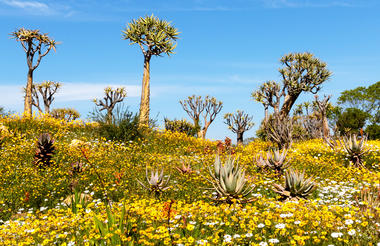
Explore this remote part of South Africa. The Namaqua National Park should not be missed, the scenery is spectacular all year 'round, and if you are here in flower season, you will be astounded at the carpet of colour covering the area. The flower season is determined by the amount and timing of winter rains and is thus extremely difficult to predict in advance. Most years, the high (flower) season takes place each year in August, September & October.
The name of the lodge - “Naries” - is a Nama word (indigenous people of this region), meaning “place where the reeds grow”. No one is quite sure of the exact location of these reeds, but it is believed to have been in one of the many non-perennial riverbeds to the east of the farmhouse. Naries is an oasis for your soul. The isolation offers serenity, clear skies and quiet nights. Breathe the freshest air… eat the best food surrounded only by sounds of nature… engage in a variety of recreational activities and simply feel yourself relaxing!This is the reason you will not find a television in your room.
Many decades of overgrazing and unscientific methods of farming had left its scars on the soil and vegetation of Naries. To allow for its recovery and the resettlement of some of the more delicate species of plants, all commercial goat farming was stopped and a program to re-establish indigenous antelope started some years later in 1999. Today Naries, although still in the midst of a process of rehabilitation, is host to some 150 Springbok; 30 Oryx and a number of Klipspringer. Plans are underway to bring back the Zebra which once roamed these hills.The harsh and barren landscape of the Namaqualand Klipkoppe (rocky hills) habitat does not lend itself to accommodating vast herds of large game. Instead it is a treasure chest of endemic plant species and a paradise for smaller but equally fascinating creatures. Look out for the myriad of beautifully coloured beetles,the long-tongued flies, butterflies and even the little mice who all play a vital role in pollinating our unique floral biodiversity.
Meals included today: Breakfast, Dinner.


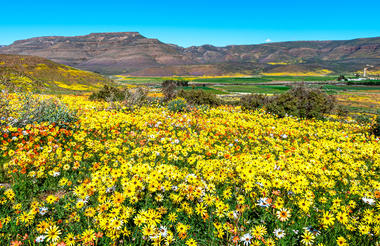
Leave Naries after breakfast and head east - towards Augrabies. The area is remote, dry and with just a few sheep farms - many say it resembles the Australian outback. Drive to Pofadder (good place to stop for lunch) and onwards to Augrabies Falls National Park. Check in at your comfortable chalet, this is the official National Park Camp accommodation. Meals can be taken in the restaurant in the camp area (at own expense).
Your chalet consists of 2 single beds, a double sleeper couch (not suitable for adults), lounge/bedroom/kitchenette, WC & Shower, AC, Microwave, kitchen equipped with crockery and cutlery, outside braai facilities, restaurant and shop on site.
Total distance - shortest route: approx 320 km
Meals included today: Breakfast



The Khoi people called it "Aukoerebis", or place of Great Noise, as this powerful flow of water is unleashed from rocky surroundings characterised by the 18km abyss of the Orange River Gorge.
Spend the day exploring the Augrabies Falls National Park. There are marked, self-guided trails that leads you on a circular route to see the Falls from different viewpoints. Several animals can be found here: Klipspringer, Springbok, Gemsbok and even the endangered Black Rhino. You are almost certain to see the cute "Dassies" (hyrax) sunning themselves on the rocks.
The animals in Augrabies Falls National Park can survive in extreme high and low temperatures. Smaller animals make use of whatever shade is available as well as burrows, rock crevices and fallen trees. An interesting mammal found in Augrabies is the cape clawless otter, their presence in the park indicates that the river ecosystem is relatively healthy. The Quiver Trees are typical of this desert region and makes for some great photo opportunities.
Meals included today: No meals included



Leave Augrabies and drive via Upington and the small settlement of Askham, to your lodge located close to the Kgalagadi Transfrontier Park. There are some small settlements on the way, recommend a stop at Aunt Koera’s Farm Kitchen. Their traditional "Roosterkoek" should not be missed. There is also a Heritage Museum nearby. GPS: 26.944411°; E 20.663022°
Arrive at Kgalagadi Lodge and check in at your Luxury Chalet. This is the ideal stop-over point before entering the Kgalagadi Transfrontier Park. The Lodge has a shop with groceries, fresh fruit and vegetables, and there is a restaurant on site serving traditional Kalahari dishes with a modern twist.
Distance Augrabies - Kgalagadi Lodge: 365 km
Meals included: No meals included.



A short distance from your lodge till you enter the Kgalagadi Transfrontier Park. (Park fees payable on arrival at the gate - currently ZAR 356 per person per day, correct as at 21 Sep 18). You will enter the park at Twee Rivieren gate. The Twee Rivieren parks camp has a small shop and you may want to stop here to buy a snack for lunch as well as some cold drinks (for own account).
The Kgalagadi Transfrontier Park straddles the border between South Africa and Botswana, and borders Namibia in the north of the Park. This is a semi-desert of red dunes and starry skies at night, the wildlife is plentiful and species suited to desert conditions thrive here. It is a photographers dream location, the black-maned Kalahari lions; maybe a leopard, the majestic Gemsbok, cheetah, hyena and the cute Meerkats are just some of the species you may be able to see.
Once you have entered the park at Twee Rivieren ("Two Rivers"), travel approx. 65 km north along the Auob River Road towards Mata Mata, to the Kamqua Picnic Site. Please allow for extra time, all roads in the Park are gravel and driving inside the park is slow, with maximum speed limit of 50 km/hr. Speeding on dirt roads is detrimental to the environment. Animals often stand motionless next to the road and are not easily seen when driving at high speed. Numerous animals are run over by fast-moving vehicles. By travelling slowly, you also produce less dust. Further, the roads are narrow with sharp turns and are dangerous when travelling at high speed.
Your hosts from !Xaus Lodge will meet guests at Kamqua Picnic Site at 14.30 on day of arrival, for onward transfer to the lodge by 4x4 safari vehicle. Please arrive at Kamqua in good time, as you may otherwise miss this transfer and there is no other way to reach the lodge. There is safe parking for your car during your stay at !Xaus Lodge.
!Xaus Lodge, a Fair Trade Tourism certified destination, offers a remote, tranquil desert experience for guests looking for total isolation, to be immersed in the environment and for an opportunity to interact with members of the resident Bushman community. It is important that guests are aware that whilst !Xaus Lodge is comfortably appointed with a high standards of service, it is nevertheless “A place to experience not merely observe”. It offers a unique experience and is not just a place to stay overnight.
Distance Kgalagadi Lodge - Twee Rivieren: 6 km
Distance Twee Rivieren - Kamqua Picnic Site: 65 km
Distance Kamqua - !Xaus Lodge (you will be transferred by the lodge 4x4 vehicle): you will traverse 90 sand-dunes and travelling time will depend on what you see on the way
Meals included: Dinner



Some important information:
!Xaus Lodge is situated in a remote desert. This means that many of the luxuries of modern life are limited or unavailable.
Water is an extremely scarce resource. It is hard and saline, and drinking water created through a reverse osmosis process. Please use this precious asset sparingly. Because linen cannot be washed in this saline water and is thus trucked to Twee Rivieren, it is not changed every day, and there are no guest laundry facilities.
Electricity is generated for four hours in the evening, and an hour mid-morning. This means no TVs, radios, electronic devices or electric kettles and espresso machines. What it does mean is wonderful hours of silence, and an opportunity to unwind from day-to-day life.
Telecommunications signals don’t reach the Lodge. No cell phone, Wi-Fi, telephone or TV signals. The Lodge and the vehicles have 2-way radio links with SANParks facilities, and management has a satellite phone for emergencies. The joy of visiting !Xaus Lodge is that you will be ‘off the grid’.
Supplies – especially food and drink - are trucked in from Upington – a 720km round trip. While the lodge tries to stock as well as possible there are occasions when supplies run out, and the hosts at the lodge cannot re-stock overnight. The meals are carefully planned, and cooked in the local Mier tradition. While the menu is fixed, please advise at time of booking of any specific dietary requirements and dislikes before arrival so that the chef can adjust the menus accordingly.
!Xaus Lodge, graded 4-star by the Tourism Grading Council of South Africa, comprises 12 individual chalets accommodating 24 guests, and a central lodge building. Communal facilities include a lounge, craft shop, dining room, central viewing deck with swimming pool and Lapa.
Guests are accommodated in en-suite chalets each with its own deck overlooking the waterhole on the pan. They have Twin or King beds, high quality mattresses and linen, with winter sheets, hot water bottles and gas heaters for the cold months and ceiling fans for the hot months. Bedside tables with bedside lamps, wardrobe, writing table and chair, Luggage rack and floor rugs complete the furnishings.
The chalets are not air-conditioned. Traditional methods, using shade and damp cloths as means of keeping cool in this environment, are explained to guests. There are no hairdryers in the individual chalets because of the limited supply of electricity, but available on request.
Bathrooms have a large shower, wash-hand basin and separate flush toilet. We provide generous quantities of rooibos soap, moisturizing hand-cream and shampoo. Water is heated by on-demand gas.
A day in the desert - these are activities included for guests at !Xaus Lodge:
Morning wilderness walks with a local guide and trackers. Here you will ‘read the newspaper’ of the night before – seeing the animal spoors, being taught about plants and desert life. The distance covered depends on the abilities and interest of the guests.
Mid-morning walk on the pan. Go for a brief walk on the pan and get to understand the enormity of these desert salt pans.
Visit the local crafters. !Xaus Lodge is owned by the local ‡Khomani San and Mier communities. Guests are invited to meet the crafters while at work, and get an insight into the modern lives of the local Bushman community, as well as an opportunity to purchase crafts from the original artists.
Game drives. The lodge offers afternoon or evening game drives, giving guest an opportunity to see the ‘dune streets’ and the game and birds in the area. This is a desert park and sightings are unpredictable and fascinating.
Sundowners on the dunes. A special treat for everyone is the evening ‘sundowners’ where guests are able to listen to the sunset from the top of a dune on the opposite side of the salt pan to the Lodge.
Night sky viewing and stargazing is wonderful at !Xaus Lodge. With no ambient light pollution the night sky is spectacular. Learn about the constellations with your naked eye, or view the Milky Way through the lodge telescopes.
A favourite activity of all guests at !Xaus Lodge is the opportunity to relax and do nothing. Each chalet has a viewing deck with chairs, and you are welcome to relax quietly any time during your visit.
Meals included: Breakfast, Lunch, Dinner



You will be transferred to Kamqua Picnic Site after breakfast at !Xaus Lodge. Drive south, to Twee Rivieren and exit the Kgalagadi Transfrontier Park. Drive to Upington and check in at your guesthouse. Rest of day at leisure.
Distance Kamqua - Upington: approx. 320 km
Meals included: Breakfast

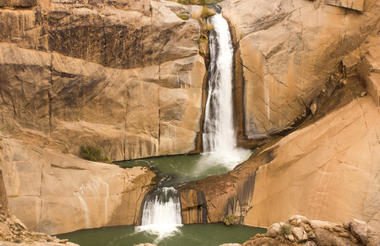

Leave Upington and drive to Kimberley, we recommend taking the shortest route via Griekwastad. Remote, semi-desert areas with sparse vegetation and few inhabitants. Griekwastad (previously Griquatown) was the first town to be established north of the Orange River, and has an interesting history. Griekwastad began its history as a mission station, and was at one stage the capital of the British Colony of "Griqualand West". Continue to Kimberley, the capital of Northern Cape Province, and check in at your guesthouse.
Distance Upington - Kimberley: approx. 400 km
Meals included: Breakfast
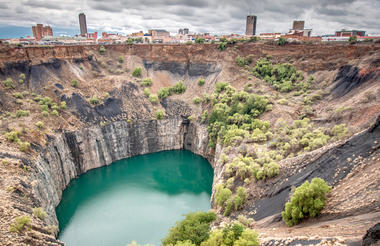
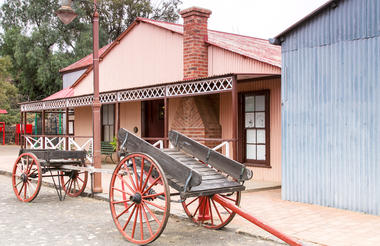
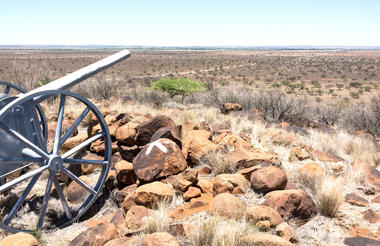
Kimberley gained fame due to the diamond prospecting, and you can see the "Big Hole" which is the largest man-made excavation in the world. We strongly recommend that you spend the day visiting the "Big Hole and Kimberley Mine Museum". The diamond era started in 1866 with the find of a small, shiny stone in this area, which was found to be a diamond - the famous "Eureka Diamond". This attracted big numbers of diggers who came to Kimberley to seek their fortune. During the period 1871 - 1914, more than 50000 miners dug the big hole by hand, and found close to 3 tons of diamonds. Another famous diamond - "Star of South Africa" - was also found here. Learn more about this fascinating history during your visit to the "Big Hole and Kimberley Museum."
Meals included: Breakfast



Leave Kimberley and head for the Karoo region of Northern Cape. This is a dry land, but with the first rains, the seemingly arid soil of the Karoo bursts into abundant life. The hardy succulent plant and trees complement the sweet grasses on which the region's merino and fat-tailed sheep graze. The ever present wind-pumps testify to the countless streams flowing between fissures underlying the dry but fertile soil.
There are some small, isolated yet welcoming villages; a distinct Karoo architecture and imposing churches in the valleys, between the desolate, flat-topped hills. Sheep farming has long been the most important agriculture, there are also farms breeding springbok. Karoo Lamb is a famous brand, the animals graze on the many small shrubs and wild herbs and the meat has a distinct flavour, which is in high demand. Angora goats is also a popular livestock. Angora wool is in high demand all over the world.
Your drive today will take you through the small villages of Jacobsdal, Koffiefontein ("coffee stream") and Petrusville. Arrive at your guest farm located near Hannover.
This is a working farm, and the accommodation is clean, simple and authentic. This is a family-run guesthouse and you can feel the warmth and kindness of your hosts. Their passion for the farm and the region they live in, will also open your eyes to the beauty of this semi-desert area. Traditional, wholesome food, clean air, starry skies at night - a complete rejuvenation for the soul.
Distance Kimberley - Karoo-Gariep: approx. 320 km
Meals included: Breakfast, Dinner



You are on a working farm and also a nature reserve. This morning, a walking tour on the farm together with the owner, this is approximately a 2 km guided walk where you will learn about the early history of the San people and their relationship with nature. The Anglo-Boer war also left its mark here, and you can hear stories of some of the skirmishes and battles that took place more than a hundred years ago.
The middle of the day is for relaxing and enjoying the swimming pool. Late afternoon, join the owner on a trip to the Hippo Pool, for sundowners. The farm owner is a keen conservationist and he introduced hippos back to this area approximately 15 years ago, there were hippos in the local rivers several hundred years ago but the last wild hippo was shot by a hunter in the 18th century. This re-introduction of hippos is an exciting development in returning some of the wildlife to the area. Enjoy a sunset drink on the viewing deck at the hippo pool.
This is followed by a Night-drive, where you may be able to see the "Karoo Shy 5", these seldom-seen animals are all found here. The "Karoo Shy 5" are the Aardvark, Aardwolf, Bat Eared Fox, Cape Fox and the Black Footed Cat. On clear evenings a stop will also be made to admire the starry skies.
Meals included: Breakfast, Dinner



Following the N1 south, you travel via Beaufort West and arrive in Prince Albert. This small town was earlier just another 'sleepy' Karoo village. In recent years, this town has become one of the most popular villages to live in, and many have moved to Prince Albert to enjoy the quality of life. The town has a beautiful architecture, fascinating flora and fauna and great hospitality. The town is located just 2 km from the impressive Swartberg Pass, and in the area there are olive farms, wine estates as well as nature reserves.
Your accommodation will be in a restored olden-style farm cottage in the village. Easy walking distance to several excellent restaurants is another plus!
Distance Karoo-Gariep - Prince Albert: approx. 560 km
Meals included: Breakfast



Hiking, biking, birdwatching and excursions are major attractions in Prince Albert. The architecture is admired, there are many well-preserved Cape Dutch, Karoo and Victorian buildings. The area is known for the excellent sun-ripened fresh fruit as well as for the dry fruit.
There is a cooking school in Prince Albert and there is no shortage of cosy restaurants to sample some delicious traditional cuisine.
Visit a wine farm or a cheese farm. Prince Albert has many small museums which you may like to visit.
Another recommendation is to take a circular drive via the Meiringspoort and the impressive Swartberg Pass, a round trip of approximately 200 km.
Something a bit different? Why not book an optional "Ghost Tour", this is a 1-hour pre-dinner walking tour of Prince Albert, where you will hear stories of some of the village characters, stories of ghosts and other peculiarities of Prince Albert.
Meals included: Breakfast



You are bound to be sad to leave Prince Albert, but new experiences are waiting for you. Drive via Laingsburg, and up into the highlands to Sutherland - according to meteorological statistics, this is the coldest place in South Africa! It is also South Africa's prime star-gazing location due to the lack of light pollution. Check in at your guesthouse in Sutherland.
More than 25000 years ago, the San people who lived in this area, knew the movements of the stars and wove this knowledge into their lives. Today, the extraordinary clarity of Sutherland’s cloudless, pollution-free night skies and its high elevation above sea level makes it a prime star-gazing destination and the perfect site for the South African Astronomical Observatory. The observatory houses the largest single optical telescope in the Southern Hemisphere.
We have booked a Stargazing session with you this evening. A local astronomer will guide you to identify some of the stars and different constellations, as well as teach you how to find due south using the Southern Cross.
Distance Prince Albert - Sutherland: approx. 260 km
Meals included: Breakfast



Dress warmly for the Stargazing - evenings in Sutherland can be very cool even in summer. In winter, come prepared with anoraks, scarves and gloves!
Leave Sutherland after breakfast and drive back towards the N1. We highly recommend that you allow time to stop in Matjiesfontein, this is on your route and should not be missed. The small village was founded in 1884 and became a popular Victorian heath spa. Matjiesfontein is now a museum town. Stop to see The Lord Milner Hotel, the old Post Office, Court House & Jail and other town buildings.
Continue on the N1 to Cape Town, and hand back your rental car at Cape Town's International Airport, where your tour ends.
Distance Sutherland - Cape Town Int. Airport: approx. 350km
Meals included: Breakfast

